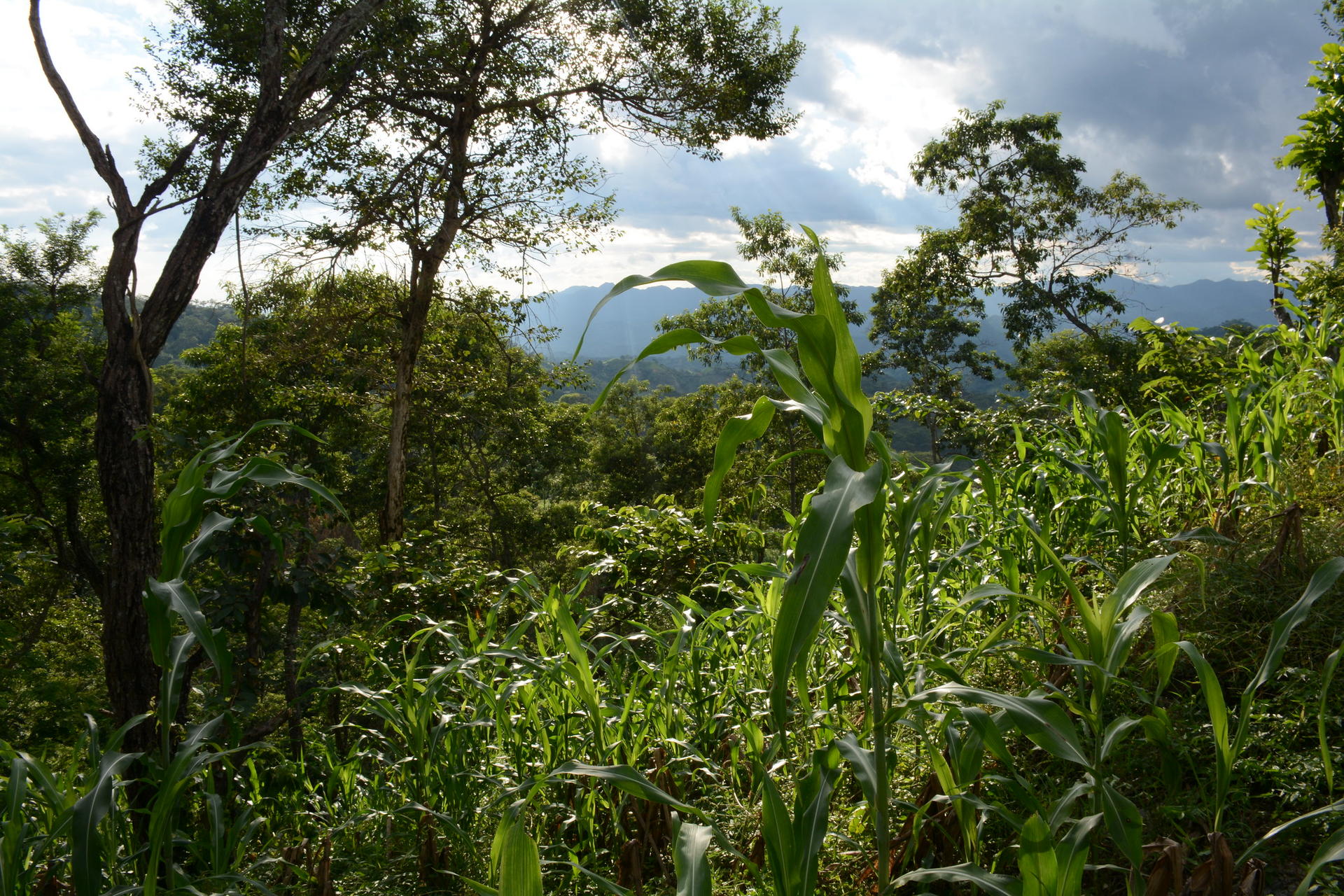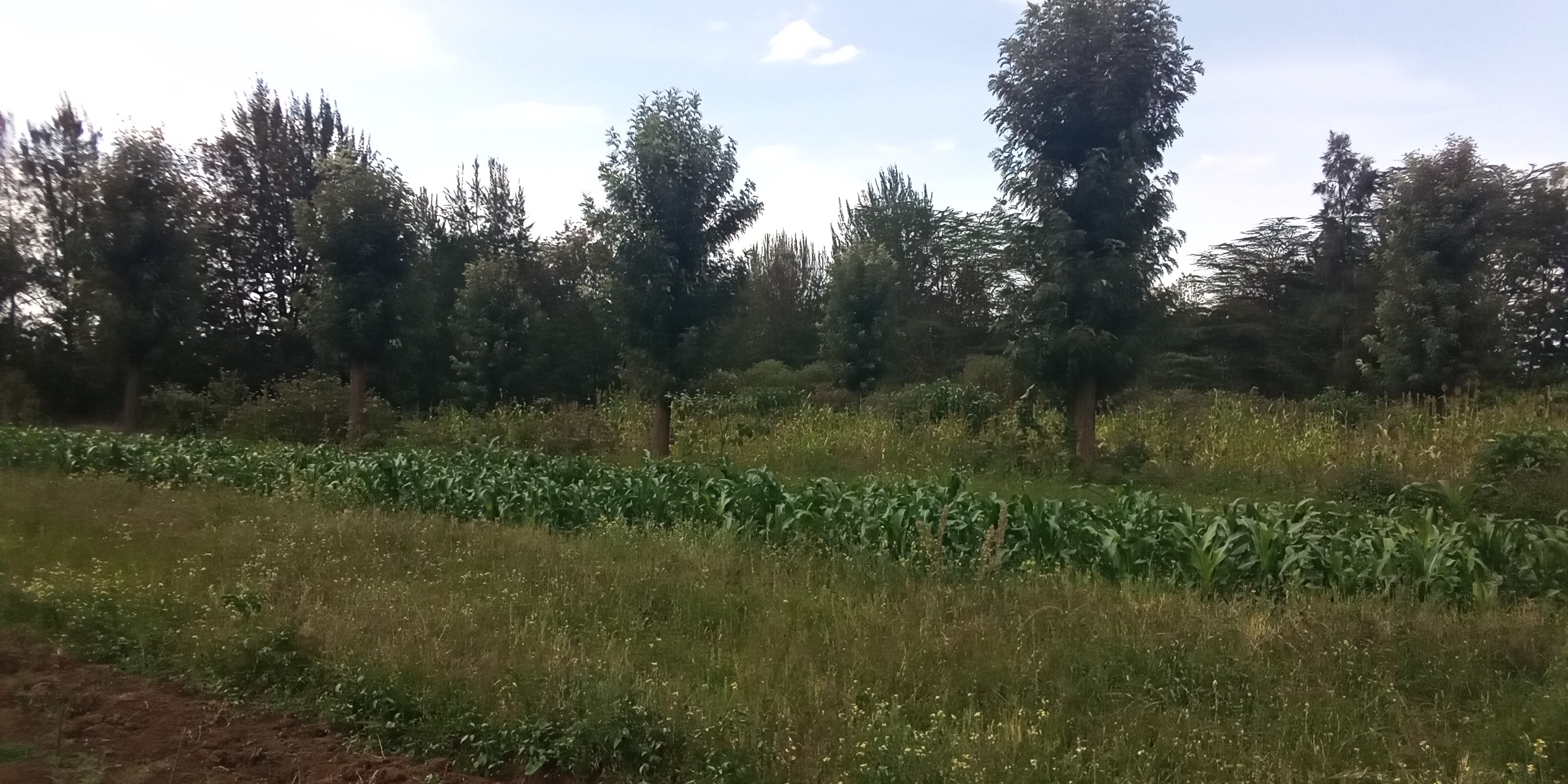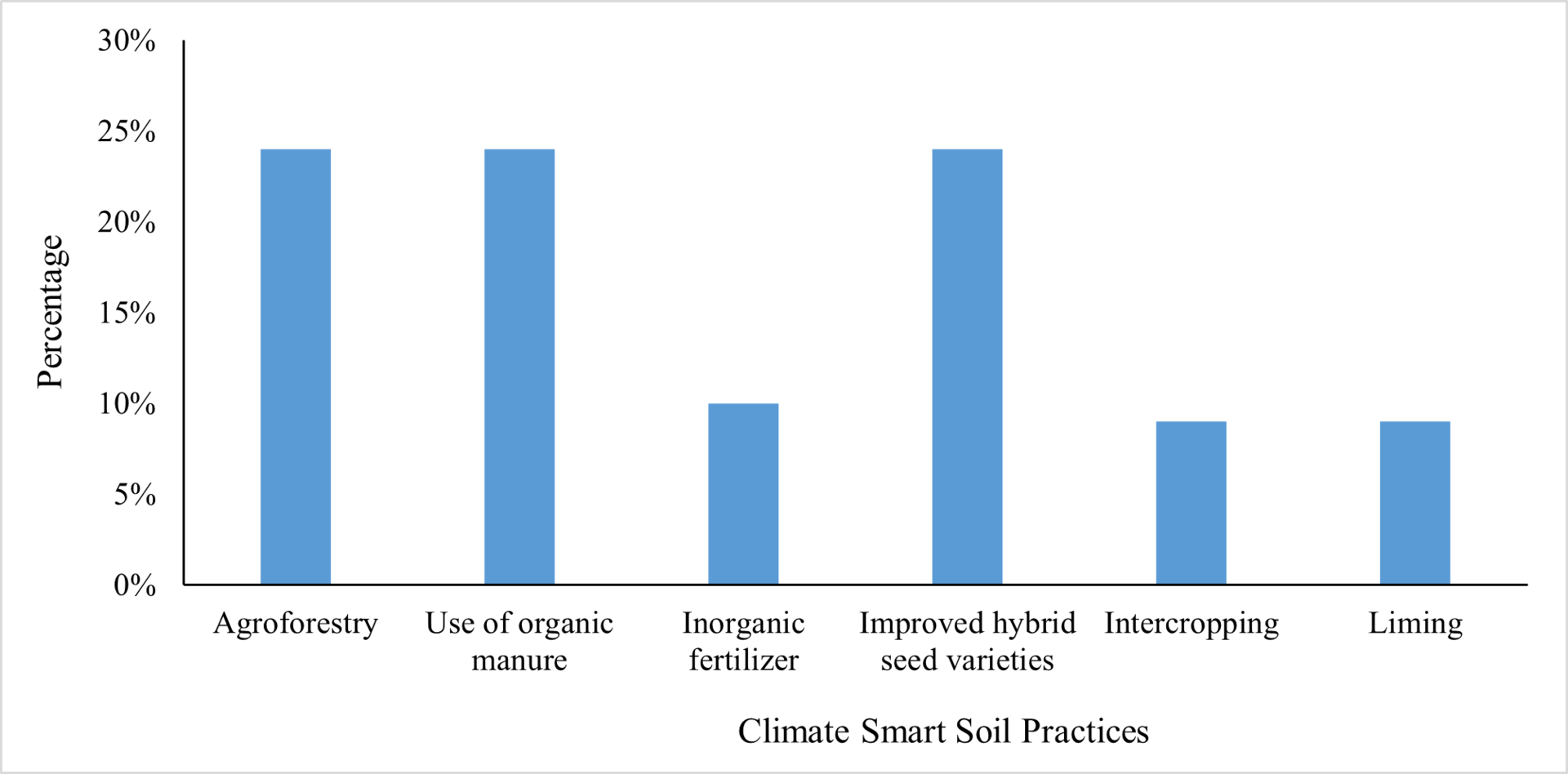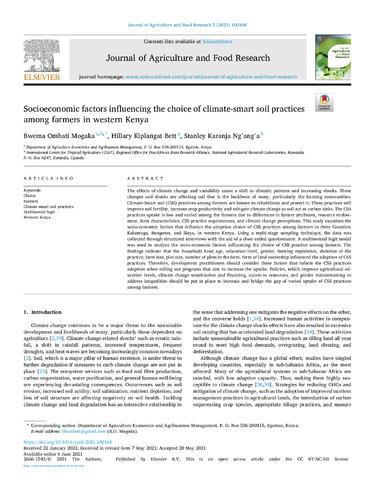Research Articles An investigation of socioeconomic factors influencing farmer preference of climate smart soil practices

By Bwema Ombati Mogaka, Hillary Kiplangat Bett, and Stanley Karanja Ng'ang'a
- Climate-Smart Soil (CSS) practices adoption as a way of restoring degraded lands, improving food security, and mitigating the effects of climate change in Western Kenya
- Scientists investigate socioeconomic factors influencing farmers' CSS practices preference.
The adoption of Climate-Smart Soil (CSS) practices is increasing in Western Kenya as farmers try new ways of protecting and rehabilitating soil to improve agricultural productivity. The most preferred CSS practices are:
- agroforestry, incorporates the cultivation and conservation of trees together with crops,
- intercropping where two or more crops grow in the same plot and,
- liming of soil-the addition of calcium compounds to the soil.
Others include:
- inorganic fertilizers- chemical fertilizers to improve soil fertility,
- organic manure- using animal droppings to enrich the soil and,
- improved hybrid seeds- using seeds with superior traits such as high yielding and disease resistance to improve crop productivity.
The adoption and preference of CSS practices varies due to socioeconomic factors (age, gender, farm size, land tenure system, number of plots, plot sizes, and experience in farming). The practices pose different human and physical demands in terms of labour and resources, thus influencing farmers’ preferences.
For the continued adoption of CSS practices, it is important to understand the effects of socioeconomic factors on the farmers' preference. For instance, intercropping is labor-intensive and requires a farmer to be physically fit or hire labour to sustain the practice. Furthermore, most farmers in Western Kenya do not practice precision agriculture, and there is a probability of overusing chemical fertilizers, which increases soil acidity rendering it less productive. To reduce the acidity, farmers should practice soil liming. However, due to limited knowledge and financial constraints, farmers rarely practice soil liming. Hence increasing capacity building and knowledge sharing on the importance of regular soil liming and acquiring non-farm income to afford the CSS practice is necessary. Knowing the significance of these socioeconomic factors will enlighten farmers on adopting a given CSS practice for continuous implementation.
Soil protection and rehabilitation through the adoption of climate-smart soil practices
Soil protection and rehabilitation efforts through sustainable agricultural practices cannot be over-emphasized. CSS practices aim to solve the problem of declining agricultural productivity and help to mitigate greenhouse gases (GHGs) such as carbon dioxide (CO2), methane (CH2), and nitrous oxide (N2O) that contribute to climate change. CSS practices such as intercropping legume crops contribute to reducing the emission of GHGs as they release 5-7 times less GHGs per unit compared to other crops in addition to fixing atmospheric nitrogen. Agroforestry systems help farmers increase crop yields by maintaining soil fertility by releasing nutrients from tree residues and reclaiming degraded land, thereby preserving water losses, soil organic matter, and nutrients.
The German Agency for International Development (GIZ) in 2016, through the International Center for Tropical Agriculture (CIAT), initiated a soil protection and rehabilitation project. The project research team evaluated six CSS practices implemented in Western Kenya shown below.
CSS Practices and potential benefits
These CSS practices are being implemented in Western Kenya and have potential benefits as listed below.
Agroforestry
- Enhances resilient and sustainable food production and increases crop productivity
- Reclaim eroded and degraded land
- Some trees used, such as Sesbania seban, improve nitrogen availability.
- Protects soil from erosion, enhances regeneration, and increases biomass.
- They act as carbon sinks hence reducing the emission of GHGs.
Intercropping
- Increases crop productivity and diversity.
- An intercrop of cover crops protects soil and water loss through erosion and surface evaporation, respectively.
- Nitrogen-fixing legumes increase soil fertility, therefore reducing the emission of nitrous oxides through increased use of chemical fertilizers.
- Improves soil structure and water infiltration
Organic manure
- Improves soil structure and biomass.
- Increases soil biodiversity biomass, enhances soil organism and microbial activity.
- Increases crop productivity.
- Proper management of animal manure reduces the emission of GHGs such as methane.
Inorganic fertilizer
- Increases crop productivity
- Replenish soil nutrients much faster
Improved hybrid seeds
- Increases crop productivity hence protecting soil from excessive mining since farmers have sufficient food.
- Drought tolerant and short maturing varieties help farmers cope with climate shocks.
Soil liming
- Reduces soil acidity, thus improving crop productivity through efficient utilization of nutrients.
- Enhance soil capability to sequester more carbon.

Socioeconomic factors influencing farmer CSS practice preference
The proportion of farmers applying CSS practices on their farms varied due to the differences in farmer socioeconomic characteristics. Agroforestry, organic manure, and improved hybrid seed were the most preferred CSS practices (24%), followed by inorganic fertilizer (10%), while intercropping and liming were the least preferred (9%) among sampled farmers. The high preference for agroforestry, organic manure, and improved hybrid seed was attributed to the many benefits they offer indicated in Table 2. The high cost of inorganic fertilizer was attributed to its low preference, while intercropping and liming were the least preferred due to high labour demands and capital requirements, respectively.

Figure 1. Proportion of farmers applying the Climate Smart Soil practices on their farms

Figure 1
Some of the socioeconomic factors that influenced the preference of CSS practices include education level, gender of the household head, and years of farming experience. For instance, farmers with a secondary education level were more likely to practice inorganic fertilizer and soil liming simultaneously (i.e., the probability of applying inorganic fertilizer increased by nine percent, and that of soil liming by 15%). A plausible explanation can be that educated farmers understand the effect of the overuse of inorganic fertilizer and the remedy (use of soil lime to stabilize acidity). In addition, educated farmers are likely to secure off-farm income, making these practices affordable.
The probability of preferring intercropping and liming among female-headed households decreased by 15% and 10%, respectively. The result suggests that in comparison to male- headed households, women are less likely to choose intercropping and liming as their preferred CSS practices since they are labour and capital-intensive. Our findings, therefore, suggest that improving levels of education, and credit access among farmers, especially women, will increase the adoption of CSS practices.
| Explanatory variable | Agroforestry | Organic manure | Inorganic fertilizer | Intercropping | Liming | |||||
| Marginal effects | Significance level | Marginal effects | Significance level | Marginal effects | Significance level | Marginal effects | Significance level | Marginal effects | Significance level | |
| Edulev¹ 2 | -0.08 | 0.487 | -0.12 | 0.332 | 0.09*** | 0.005 | 0.0006 | 0.994 | 0.15*** | 0.004 |
| 3 | 0.04 | 0.793 | -0.03 | 0.854 | 0.17** | 0.018 | -0.04 | 0.625 | 0.07** | 0.023 |
| 2.Gender² | 0.19 | 0.127 | 0.05 | 0.642 | 0.08 | 0.338 | -0.15*** | 0.000 | -0.11*** | 0.000 |
| Logfarmexp³ | -0.18** | 0.042 | -0.18* | 0.085 | 0.02 | 0.798 | -0.02 | 0.767 | 0.09 | 0.342 |
| Logduropract⁴ | -0.07 | 0.383 | 0.09 | 0.296 | 0.06 | 0.216 | 0.02 | 0.549 | -0.08*** | 0.009 |
| Logfarmsize⁵ | -0.03 | 0.809 | -0.17 | 0.225 | 0.23** | 0.016 | 0.04 | 0.545 | 0.0006 | 0.991 |
| 1.credituse⁶ | 0.003 | 0.970 | 0.004 | 0.963 | 0.05 | 0.514 | 0.06 | 0.388 | -0.02 | 0.719 |
| LogAvPlotsize⁷ | -0.12 | 0.161 | 0.02 | 0.833 | -0.06 | 0.460 | 0.16** | 0.024 | -0.02 | 0.724 |
| LogNoplots⁸ | 0.07 | 0.494 | -0.23** | 0.023 | -0.01 | 0.882 | 0.17** | 0.014 | -0.05 | 0.595 |
| Logage⁹ | 0.48** | 0.029 | 0.13 | 0.533 | 0.10 | 0.618 | -0.02 | 0.194 | -0.09 | 0.646 |
| 2.Rented_Borrowedland¹⁰ | 0.10 | 0.404 | 0.05 | 0.663 | -0.13*** | 0.000 | -0.20*** | 0.000 | 0.07 | 0.329 |
| Logownland¹¹ | 0.11 | 0.397 | 0.14 | 0.370 | -0.13 | 0.210 | -0.23** | 0.033 | 0.06 | 0.460 |
***,**,* = Significant at 1%, 5% and 10% probability level respectively.
Table 2. ¹Education level of the household head 1 denoting primary level, 2 secondary level, 3 tertiary level; ²Gender 1 denoting mal and 2 female; ³Farming experience in years; ⁴Duration of CSS practice; ⁵Farm size; ⁶Credit use; ⁷Average plot size; ⁸Number of plots; ⁹Age of the household head in years; ¹⁰Size of rented and borrowed land; ¹¹Size of own land in acres
The findings from this study are also helpful for policymakers and development practitioners because they inform on the critical factors influencing farmers CSS practice choices. These factors should be considered when making soil-based climate change investment portfolios. Therefore, sustainable adoption of CSS practices requires farmer-specific approaches. An increase in knowledge and capacity building for famers on land tenure security rights and access to credit with minimum interests will improve the adoption of CSS practices and appeal to younger farmers and those new to the industry.

